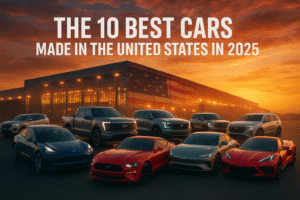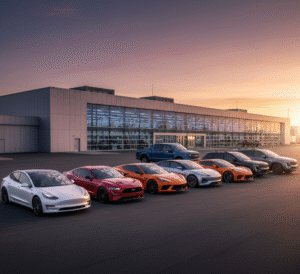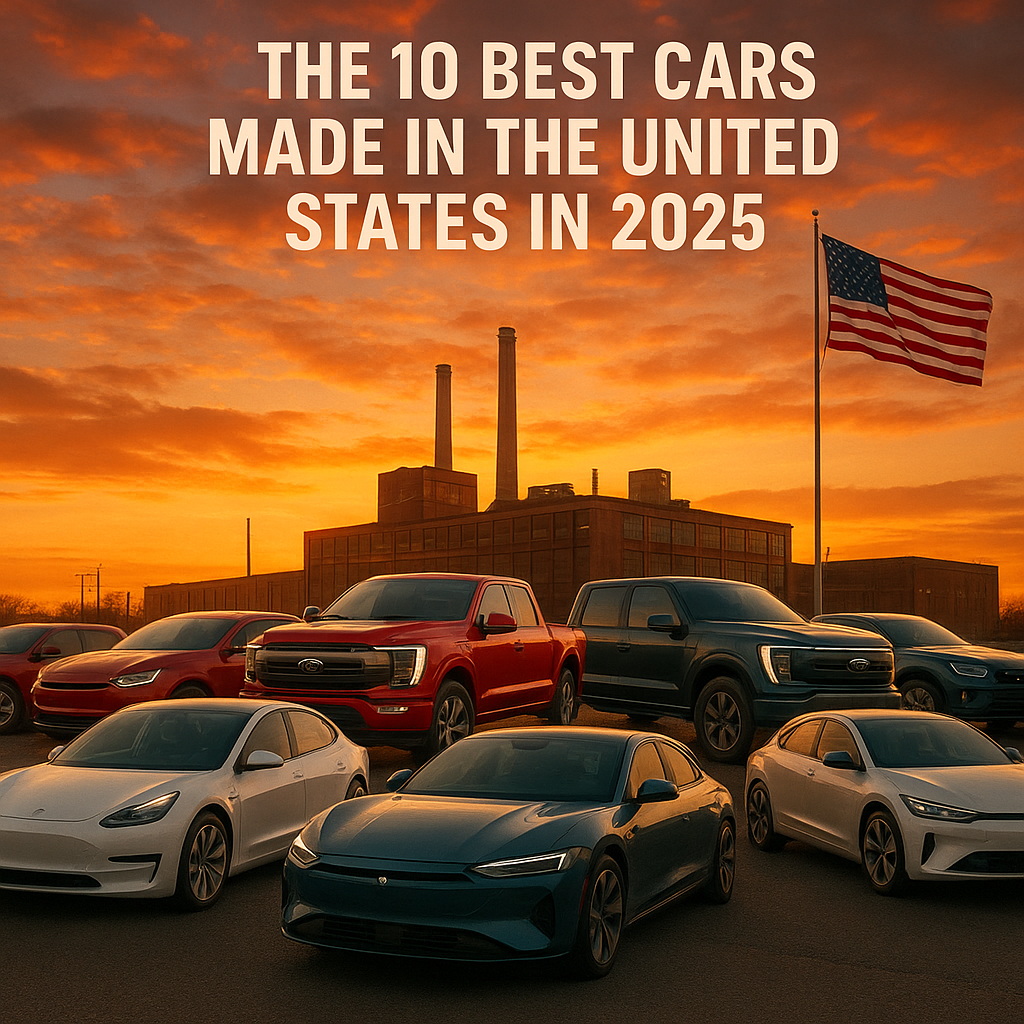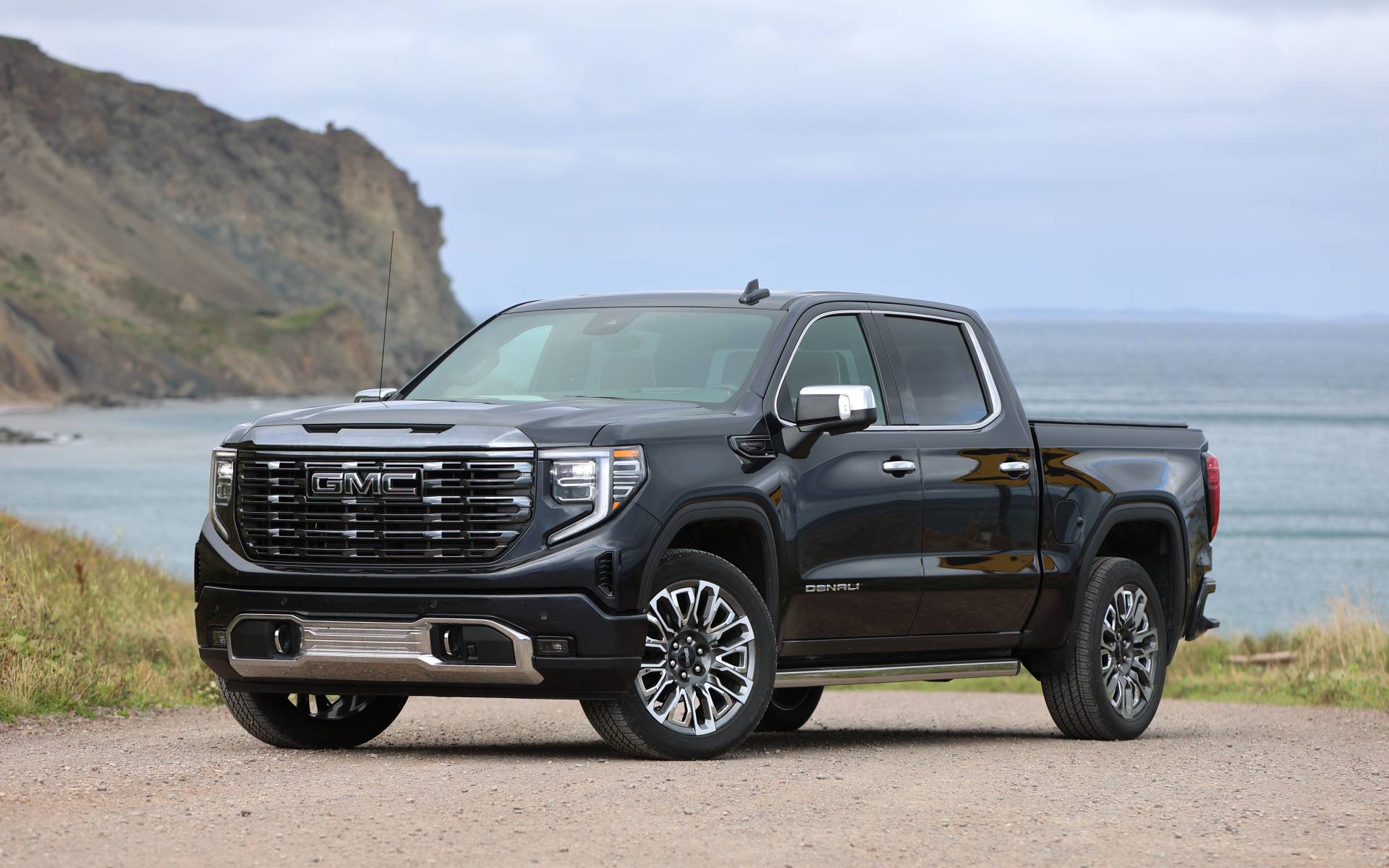The 10 Best Cars Made in the United States in 2025: From EVs to Muscle Icons
The question of what constitutes a truly “American-made” vehicle has grown increasingly complex in our globalized automotive industry where supply chains span continents, manufacturing operations cross borders, and corporate ownership structures blur national identities. A Toyota built in Kentucky with 75% domestic content competes for “most American” designation against a Ford assembled in Mexico with imported components, while Tesla vehicles manufactured in California and Texas challenge traditional assumptions about which brands represent authentic American automotive production.
Cars.com’s American-Made Index (AMI) attempts to cut through this complexity by establishing objective criteria that measure domestic manufacturing content rather than relying on brand heritage or corporate nationality. The 2025 edition of this influential ranking—now in its 20th year—reveals fascinating trends about American automotive manufacturing’s evolution, particularly the dramatic rise of electric vehicles dominating what was once the exclusive territory of traditional Detroit iron.
The 2025 AMI results tell several interconnected stories: Tesla’s complete domination of the top rankings demonstrates how the EV revolution has fundamentally reshaped American automotive manufacturing; traditional American brands like Ford maintaining strong showings despite intense competition validates their continued manufacturing commitment; and surprising entries from Korean and startup brands highlight how “made in America” increasingly transcends corporate nationality to reflect genuine manufacturing and employment footprints.
Understanding the 2025 rankings requires examining not just which vehicles made the list but why the criteria matter, how American automotive manufacturing has evolved, what these rankings reveal about industry trends, and most importantly, why consumers increasingly care about domestic content when making purchase decisions that represent some of their largest financial commitments.
Introduction: Defining True Domestic Automotive Craftsmanship
Cars.com American-Made Index (AMI) Criteria and Its Five Factors
The American-Made Index distinguishes itself from simplistic “assembled in America” marketing claims by employing a comprehensive five-factor methodology that captures the full scope of domestic manufacturing contribution:
Assembly Location: Where final vehicle assembly occurs fundamentally affects employment and economic impact. A vehicle assembled in Michigan directly employs American workers operating the assembly line, welding body panels, installing components, and conducting quality inspections. This factory employment creates multiplier effects—workers’ wages support local businesses, tax revenues fund community services, and manufacturing expertise develops regional skill bases. The AMI awards points based on whether assembly occurs in the United States, recognizing that final assembly represents substantial economic value even when components originate elsewhere.
However, assembly location alone provides incomplete picture. A vehicle could be “assembled in America” while containing predominantly imported components, limiting actual domestic economic benefit. This reality necessitates the additional factors that measure content beyond mere assembly location.
US/Canadian Parts Content: The percentage of parts sourced from United States or Canadian suppliers indicates how much of the vehicle’s value chain remains in North America. Federal regulations require manufacturers to disclose parts content percentages, allowing the AMI to incorporate this data into rankings. Higher domestic parts content means more manufacturing employment, more supplier company profits, and greater economic benefit remaining within North American economies rather than flowing to overseas suppliers.
The inclusion of Canadian content alongside American reflects NAFTA/USMCA trade relationships that deeply integrate US and Canadian automotive manufacturing. Many vehicles source major components from both countries, and excluding Canadian content would misrepresent the North American manufacturing footprint. However, the AMI weights this factor to emphasize that truly “American-made” vehicles maximize US-specific content when possible.
Engine Origin: Engines represent vehicles’ most complex and valuable single components, requiring sophisticated manufacturing capabilities and highly skilled workforces. An engine built in America indicates advanced manufacturing capacity, engineering expertise, and substantial employment beyond simple parts assembly. The AMI awards points for engines manufactured domestically, recognizing their outsize importance to overall domestic content.
The engine origin factor also reflects technological evolution. Traditional internal combustion engines involve completely different manufacturing processes than the electric motors powering EVs. As the industry transitions toward electrification, this factor adapts to evaluate electric motor production locations rather than becoming irrelevant.
Transmission Origin: Transmissions similarly represent complex, high-value components requiring advanced manufacturing. Whether discussing traditional automatic transmissions, manual gearboxes, continuously variable transmissions (CVTs), or the single-speed reduction gearboxes in many EVs, transmission production location indicates manufacturing sophistication and employment impact.

Labor and Employment Impact: Beyond the component-level analysis, the AMI considers overall employment footprint—how many American workers the vehicle’s production employs across all facilities and suppliers. This holistic employment measure captures economic benefits that component-by-component analysis might miss, recognizing that domestic content matters ultimately because of its employment and economic development implications.
These five factors combine into composite scores that rank vehicles from most to least American-made. The methodology’s sophistication prevents gaming the system—manufacturers cannot achieve high rankings through single-factor optimization (like assembling in America while importing all components) but must instead demonstrate comprehensive domestic manufacturing commitment across the full value chain.
Context of 2025 AMI: A 20th Year Marked by EV Dominance
The 2025 American-Made Index’s 20th anniversary provides opportunity to reflect on two decades of American automotive manufacturing evolution. When Cars.com launched the AMI in 2006 (counting back from 2025), the rankings heavily featured traditional Detroit Three vehicles—Ford F-150s, Chevrolet Silverados, Dodge Rams—representing the conventional wisdom that “American-made” meant vehicles from American-branded companies manufactured in traditional automotive heartland states.
The intervening two decades witnessed dramatic transformations. Foreign-branded manufacturers—particularly Japanese and Korean companies—invested billions building American assembly plants and developing domestic supplier networks, often achieving higher domestic content percentages than traditional American brands that increasingly sourced globally. The 2008 financial crisis and subsequent bankruptcies of GM and Chrysler accelerated industry restructuring that further blurred national identity lines.
But the most dramatic shift arrived with electrification’s acceleration. Tesla’s rise from startup curiosity to America’s most valuable automotive manufacturer redefined expectations for what “American-made” could mean. Rather than legacy manufacturers with century-long histories and deep Michigan roots, Tesla—founded in California in 2003, building vehicles in Fremont and Austin with supply chains designed from scratch—came to exemplify 21st-century American automotive manufacturing.
The 2025 AMI results crystallize this transition: Tesla vehicles occupy four of the top positions, demonstrating that the most American-made vehicles now come from an EV manufacturer that didn’t exist when many traditional American brands were founded. This EV dominance reflects both Tesla’s strategic commitment to domestic manufacturing and the broader industry reality that electric vehicle production enables different manufacturing approaches than traditional automotive assembly with its complex global supply chains built over decades.
The 20-year retrospective also reveals cyclical patterns. American content percentages generally increased through the 2010s as manufacturers responded to “buy American” sentiment and favorable domestic manufacturing economics following the financial crisis. But recent years have seen pressures from global chip shortages, supply chain disruptions, and inflation challenging the economics of domestic sourcing, creating tensions between maintaining high American content and controlling costs that threaten affordability.
The 2025 results thus arrive at a pivotal moment: Will EV dominance continue expanding as more manufacturers electrify their lineups with domestically-produced EVs? Will traditional American brands reclaim AMI leadership by investing in domestic EV production? Or will the practical economics of battery supply chains (where critical minerals and cell production concentrate in Asia) ultimately limit how “American-made” EVs can realistically become? The 2025 rankings provide snapshot of these ongoing tensions that will shape American automotive manufacturing for decades ahead.

Top of the 2025 Rankings: Tesla Electric Vehicle Dominance
Tesla Model 3: America’s Most American Vehicle of 2025 (Fremont and Austin)
The Tesla Model 3’s position atop the 2025 American-Made Index represents remarkable achievement for a vehicle that didn’t exist a decade ago. When Tesla launched Model 3 production in 2017, skeptics questioned whether a manufacturer without traditional automotive experience could achieve the manufacturing scale, quality, and efficiency that established automakers spent decades developing. The Model 3’s AMI victory—representing the single most American-made vehicle available in 2025—provides definitive answer to those doubts.
The Model 3’s manufacturing footprint spans two major American production facilities. The Fremont, California factory—Tesla’s original automotive manufacturing site, a former GM-Toyota joint venture facility that Tesla acquired in 2010—produces Model 3s alongside Model Y crossovers and Model S/X luxury vehicles. The Austin, Texas Gigafactory, which began Model Y production in 2022 and later added Model 3, represents Tesla’s massive bet on Texas as its new manufacturing hub, with the facility eventually planned to produce millions of vehicles annually.
This dual-site production strategy provides several advantages that contributed to Model 3’s AMI dominance. Geographic diversification reduces risks from localized disruptions—California wildfires, Texas power grid failures, or regional supply chain problems affect only portion of total production. The two-factory approach also allows production volume that single-site manufacturing couldn’t match, with combined capacity supporting Model 3’s status as one of America’s best-selling EVs.
The domestic parts content that powered Model 3’s AMI victory reflects Tesla’s vertical integration strategy. Unlike traditional automakers that outsource most components to supplier networks, Tesla manufactures many critical parts in-house at its various facilities. Battery pack assembly occurs at the Nevada Gigafactory, with cells potentially coming from domestic production as new battery factories come online. Electric motors, power electronics, and other key components are Tesla-designed and often Tesla-manufactured rather than sourced from traditional tier-1 suppliers.
This vertical integration serves multiple purposes beyond improving AMI scores. It gives Tesla direct control over component quality and production schedules rather than depending on suppliers whose priorities might not align with Tesla’s aggressive production targets. It protects intellectual property by keeping proprietary technology in-house. And it captures more of the value chain’s profit margins rather than paying supplier markup on outsourced components.
The Model 3’s AMI victory also reflects Tesla’s employee base concentration in the United States. While Tesla operates facilities globally—in China, Germany, and potentially other international locations—its engineering, design, and advanced manufacturing workforce remains heavily American. The Fremont and Austin factories employ thousands of American workers in manufacturing roles, while Tesla’s Palo Alto headquarters and various engineering facilities employ thousands more in development, design, and corporate functions.
However, the Model 3’s AMI dominance shouldn’t obscure challenges and controversies. Battery supply chains remain Tesla’s most significant domestic content obstacle—lithium, cobalt, nickel, and other critical battery minerals predominantly come from overseas sources, while battery cell production historically concentrated in Asia. Tesla’s partnerships with Panasonic and newer relationships with LG and CATC involve some domestic battery production, but true battery supply chain localization remains works in progress requiring years of additional investment and development.
Labor relations also complicate the “most American” narrative. Tesla’s factories are non-union, contrasting with traditional Detroit Three plants represented by the United Auto Workers. Whether non-union manufacturing should be celebrated as “American-made” or viewed skeptically given union manufacturing’s historical role in building American middle class represents contested political terrain. Tesla argues its compensation packages compare favorably to union shops while offering more flexibility; critics counter that union representation provides worker protections and collective bargaining power that Tesla employees lack.
Despite these complications, Model 3’s AMI victory represents significant milestone in American automotive manufacturing history. A vehicle designed and manufactured entirely by a company founded in the 21st century, built primarily in California and Texas, powered by electricity rather than gasoline, has achieved recognition as the single most American-made vehicle available to consumers. This outcome would have seemed inconceivable when the AMI launched 20 years earlier, yet it now reflects contemporary American automotive manufacturing reality.
Tesla Model Y: Best-Selling EV with Strong Local Content
The Tesla Model Y’s high AMI ranking—likely second or third overall given Model 3’s top position and the typical pattern where multiple Tesla models cluster at the top—reflects similar manufacturing strategy to its sedan sibling while adding the commercial success dimension that makes its domestic content particularly consequential for American manufacturing employment.
Model Y’s status as America’s best-selling EV (and increasingly competitive with traditional bestsellers across all powertrains) means that its domestic content affects far more vehicles and workers than lower-volume models. When a vehicle selling 500,000+ units annually in the US maintains high American content, the employment and economic impacts multiply proportionally. Each percentage point of domestic content in a high-volume vehicle like Model Y represents vastly more American jobs and economic activity than the same percentage in a low-volume exotic or specialty vehicle.
The Model Y’s manufacturing setup mirrors Model 3’s dual-facility approach with production at both Fremont and Austin. However, Austin Gigafactory’s massive scale suggests Model Y production increasingly concentrates there as the facility ramps toward full capacity. The Texas location provides several strategic advantages: lower operating costs than California, central US geography that reduces logistics costs for delivering vehicles to customers nationwide, and favorable business climate that attracted Tesla’s headquarters relocation from California to Texas in 2021.
Model Y’s crossover/SUV configuration also affects its AMI scoring in interesting ways. The larger vehicle requires more materials and components than Model 3, potentially affecting domestic content percentages if certain components must be sourced internationally. However, crossover popularity generally allows manufacturers to invest more heavily in domestic supply chains given the higher volumes justifying supplier investment. The balance between these factors likely results in Model Y domestic content percentages similar to but perhaps slightly different from Model 3’s.
The strong local content that earned Model Y its high AMI ranking demonstrates that domestic manufacturing can succeed even in the intensely competitive mainstream SUV/crossover segment. Traditional automotive wisdom held that manufacturers needed global supply chains and lowest-cost sourcing to compete in high-volume mainstream segments, with domestic manufacturing reserved for specialty vehicles or those benefiting from brand heritage. Model Y’s success challenges this assumption, proving that domestic manufacturing can compete on quality, cost, and delivery even in the market’s most demanding segments.
Tesla Model S and Model X: Fully Electric Luxury Icons
The Tesla Model S and Model X—the company’s longest-running models, introduced in 2012 and 2015 respectively—occupy interesting positions in the 2025 AMI rankings. While likely not achieving the very highest scores given their lower production volumes and the economics of luxury vehicle manufacturing, they still probably rank highly, demonstrating that even Tesla’s premium offerings maintain strong domestic content.
Model S and Model X’s Fremont-exclusive production (they’re not currently manufactured in Austin) provides interesting contrast to the Model 3/Y dual-facility approach. The lower production volumes for these luxury models—measured in tens of thousands annually rather than hundreds of thousands—don’t justify the capital investment required for multi-facility production. Concentrating luxury production at Fremont allows Tesla to maintain specialized manufacturing expertise and quality control procedures that justify premium pricing while keeping these slower-moving models separated from the higher-volume lines.
The luxury positioning also affects parts sourcing and content strategies. Premium vehicles typically incorporate more expensive, sophisticated components that might have fewer domestic sourcing options. Luxury interiors materials, advanced suspension systems, premium audio components, and other high-end features might need to be imported if domestic suppliers don’t offer equivalent quality or if volumes don’t justify supplier investment in domestic production. These factors potentially reduce domestic content percentages relative to mainstream models even as absolute dollar values of domestic content remain high.
However, the “fully electric luxury icon” positioning also provides AMI advantages. Unlike traditional luxury manufacturers building vehicles on global platforms shared across multiple markets (creating pressure for internationally-sourced components that serve worldwide production), Tesla designed Model S and Model X specifically for US market initially, only later expanding internationally. This US-first approach enabled supply chain development prioritizing domestic sourcing rather than global supply chains optimized for worldwide production.
The combined presence of four Tesla models in the AMI’s top tier sends unmistakable message about contemporary American automotive manufacturing: the most American-made vehicles now come from an EV manufacturer that didn’t exist when most traditional automakers were founded. This reflects both Tesla’s deliberate strategy of domestic manufacturing and the reality that EV production enables different supply chain approaches than traditional automotive manufacturing with its century of accumulated global sourcing relationships.
Other Essential Models in the 2025 AMI
Kia EV6: The Non-Tesla Alternative with Highest Parts Content (80%)
The Kia EV6’s high AMI ranking—potentially the highest-ranked non-Tesla vehicle—represents fascinating development in American automotive manufacturing. A Korean-branded vehicle built in the United States achieving higher domestic content than many traditional American-branded vehicles challenges assumptions about which companies represent authentic “American-made” production.
The 80% domestic parts content figure (if accurate) represents exceptional achievement requiring comprehensive domestic supply chain development. For context, many vehicles considered “American-made” maintain domestic content in the 50-70% range, with 80% representing upper echelon requiring deliberate strategic commitment to domestic sourcing rather than simply assembling vehicles from predominantly imported components.
Kia’s American manufacturing commitment reflects decades of investment by Korean automotive companies in US production. Hyundai Motor Group (which owns Kia) operates multiple American assembly plants and has developed extensive supplier networks supporting production of engines, transmissions, and thousands of other components domestically rather than importing from Korea. The EV6’s high domestic content suggests this supplier infrastructure has evolved to support EV production, not just traditional vehicles.
The “non-Tesla alternative” positioning carries significant market implications. Consumers prioritizing domestic content but hesitant about Tesla ownership—perhaps due to concerns about charging infrastructure, brand image, or CEO controversies—now have legitimate alternative offering comparable domestic manufacturing footprint. This competition benefits consumers by expanding choices while potentially pressuring both Tesla and traditional American brands to maintain or improve their own domestic content.
The EV6’s success also demonstrates that domestic manufacturing competitiveness doesn’t require century-old brand heritage or traditional automotive heartland geography. Kia achieved high domestic content through strategic investment and supply chain development, proving that manufacturing location and employment impact matter more than corporate nationality or historical brand identity for determining what’s genuinely “American-made.”
Ford F-150: Best-Selling Pickup, Anchored in US Employment (Michigan and Missouri)
The Ford F-150’s presence in the 2025 AMI rankings—certainly somewhere in the top 10 given its manufacturing footprint—represents continuity amid the EV disruption transforming the rankings. America’s best-selling vehicle for over four decades maintains strong domestic manufacturing commitment even as newer entrants and technologies challenge traditional automotive hierarchies.
The F-150’s Michigan and Missouri assembly locations—Dearborn Truck Plant and Kansas City Assembly Plant—provide geographic diversification similar to Tesla’s dual-facility strategy while maintaining presence in traditional automotive manufacturing regions. Michigan represents Ford’s historical heartland where the company was founded and where it maintains extensive manufacturing, engineering, and design operations. Missouri provides central US location that efficiently serves nationwide customer base while offering favorable operating economics relative to coastal states.
The employment impact dimension particularly matters for F-150 given its exceptional sales volumes. When America’s best-selling vehicle maintains high domestic content, the resulting employment ripples throughout the economy. Beyond the thousands of workers directly assembling F-150s at Ford plants, the domestic parts content supports countless supplier company employees manufacturing engines, transmissions, frames, body panels, interiors, and thousands of other components. The F-150’s economic footprint arguably exceeds any other single vehicle model’s given the combination of sales volume and domestic content.
F-150’s AMI performance also reflects Ford’s strategic commitment to domestic truck manufacturing. While Ford increasingly sources other vehicles internationally or maintains lower domestic content in some models, trucks—particularly the F-Series that generates enormous profits and defines Ford’s brand identity—receive priority for domestic manufacturing investment. This strategic differentiation allows Ford to maintain “American-made” credentials for its most important products while achieving cost efficiencies through global sourcing for less critical models.
The F-150 also represents AMI’s ongoing relevance for traditional vehicles even as EVs dominate headlines. The rankings aren’t exclusively about electrification but about comprehensive domestic manufacturing commitment across powertrains. F-150’s continued presence demonstrates that internal combustion vehicles built with strong domestic content still earn recognition alongside their electric competitors.
Ford Mustang: Muscle Car Built Exclusively in Michigan
The Ford Mustang’s inclusion in the 2025 AMI rankings celebrates one of American automotive’s most iconic nameplates while recognizing its genuine domestic manufacturing commitment. Unlike many vehicles that share platforms and production facilities across global operations, Mustang production remains concentrated at Ford’s Flat Rock Assembly Plant in Michigan—a focused manufacturing strategy that supports high domestic content while maintaining connection to American automotive heritage.
The “muscle car” positioning carries cultural weight beyond simple manufacturing metrics. Mustang represents quintessentially American automotive tradition—affordable performance, distinctive styling, V8 engine options (alongside increasingly popular EcoBoost turbos), and the freedom of open-road driving that American car culture celebrates. That this icon continues being manufactured exclusively in Michigan rather than offshored to lower-cost locations validates Ford’s commitment to maintaining heritage vehicle production in traditional automotive heartland.
Flat Rock’s Mustang-focused production also enables specialized manufacturing approaches that support higher domestic content. Rather than shared production lines building multiple vehicle types with globally-optimized supply chains, Flat Rock can develop Mustang-specific supplier relationships prioritizing domestic sourcing. This focused strategy allows achieving domestic content percentages that might be impractical for high-volume mainstream models requiring lowest possible costs to remain price-competitive.
However, Mustang’s AMI inclusion also highlights an interesting transition. Ford recently introduced the Mustang Mach-E, an electric crossover wearing the Mustang name and manufactured in Mexico. The traditional Mustang’s Michigan production and likely higher domestic content contrasts with Mach-E’s international production strategy, raising questions about whether the Mustang name’s expansion dilutes its “American-made” credentials or whether maintaining traditional Mustang’s domestic production outweighs the Mexican-built Mach-E.
Jeep Grand Cherokee: Flagship SUV Assembled in Detroit
The Jeep Grand Cherokee’s AMI ranking recognizes both its manufacturing footprint and its significance as the flagship model for one of American automotive’s most heritage-rich brands. Grand Cherokee assembly at Detroit Assembly Complex places this premium SUV in the historical heart of American automotive manufacturing while supporting substantial local employment and supplier economic impact.
The Detroit assembly location carries symbolic importance beyond practical manufacturing considerations. Building Grand Cherokee in Detroit—a city whose identity is inextricably linked to automotive manufacturing and that suffered devastation when that industry contracted—represents commitment to maintaining manufacturing presence in traditional automotive communities. This isn’t just about efficiency or costs but about corporate responsibility to communities that built the industry.
Grand Cherokee also demonstrates that premium SUVs—vehicles typically commanding higher prices and profit margins—can maintain strong domestic content while offering the features and quality that luxury customers demand. The assumption that premium vehicles require internationally-sourced luxury components and sophisticated technology doesn’t hold when manufacturers prioritize domestic suppliers capable of delivering required quality levels.
However, the Grand Cherokee AMI entry likely comes with caveats about which specific variants qualify. Jeep produces multiple Grand Cherokee variants including the three-row Grand Cherokee L and the performance-oriented Grand Cherokee Trackhawk. If only certain variants are assembled in Detroit while others come from different facilities, the AMI might rank only the Detroit-built variants, potentially creating consumer confusion about which Grand Cherokee they’re actually purchasing if “American-made” content influences their decision.
New Entrants and Domestic Niche Segments
Rivian R1T and R1S: Emerging EV Manufacturer Based in Illinois
Rivian’s inclusion in the 2025 AMI rankings represents one of the index’s most significant developments—the recognition of a completely new American automotive manufacturer achieving meaningful domestic manufacturing footprint just years after beginning production. The Rivian R1T pickup truck and R1S SUV, both manufactured at Rivian’s Normal, Illinois facility, demonstrate that American automotive entrepreneurship continues generating new manufacturers capable of competing against established giants.
The Illinois manufacturing location—a former Mitsubishi plant that Rivian acquired and extensively renovated—places Rivian outside traditional automotive manufacturing regions, demonstrating that American auto production need not concentrate exclusively in Michigan or Southern states’ foreign transplant facilities. Illinois gains manufacturing jobs and economic development from Rivian’s presence while Rivian benefits from existing facility infrastructure and local workforce with some automotive manufacturing experience.
Rivian’s AMI performance is particularly impressive given the challenges facing startup manufacturers. Established automakers benefit from decades of supplier relationships, manufacturing expertise, and economies of scale that new entrants must develop from scratch while competing against products refined over generations. That Rivian achieved AMI-worthy domestic content while building completely new manufacturing operations and supply chains in just a few years validates both the company’s execution and the viability of new American automotive manufacturing even in the industry’s mature, capital-intensive state.
The R1T and R1S’s adventure-oriented positioning also demonstrates domestic manufacturing’s viability across vehicle segments. These aren’t mainstream high-volume sedans where cost pressures demand global sourcing, but relatively low-volume specialty vehicles serving niche markets. Their AMI inclusion suggests that domestic manufacturing can succeed in premium niches where brand differentiation and American manufacturing heritage provide competitive advantages outweighing any cost disadvantages from domestic sourcing.
However, Rivian faces significant challenges maintaining and growing its domestic content as production scales. Current modest production volumes allow supplier relationships and sourcing strategies that might not remain viable as Rivian pursues its ambitious growth targets. Battery supply remains particularly challenging given global battery cell production concentration. Whether Rivian can maintain high domestic content while scaling to hundreds of thousands of annual units will test whether startup manufacturers can match Tesla’s domestic manufacturing achievement or whether Tesla’s scale advantages prove insurmountable.
Lucid Air: Luxury Electric Sedan Manufactured in Arizona
The Lucid Air’s inclusion in the 2025 AMI rankings adds another startup EV manufacturer to the index, demonstrating that the Rivian case isn’t isolated but rather represents broader pattern of new American EV manufacturers achieving meaningful domestic production footprints. The Lucid Air’s Arizona manufacturing location—specifically Casa Grande, Arizona—provides another data point showing American EV production dispersing geographically beyond traditional automotive regions.
Arizona offers several advantages for automotive manufacturing that likely influenced Lucid’s location decision. Land costs and operating expenses generally run lower than California (where Lucid is headquartered) while remaining far below East Coast levels. The desert climate minimizes weather-related production disruptions—no hurricanes, rare flooding, minimal snow—that can affect facilities in other regions. And Arizona’s geographic position allows relatively efficient shipping to West Coast, Southwest, and Southern markets that likely represent core Lucid customer demographics.
The “luxury electric sedan” positioning places Lucid Air in interesting AMI territory. Luxury vehicles typically incorporate expensive, sophisticated components potentially requiring international sourcing if domestic suppliers don’t offer equivalent quality. Premium brands also traditionally emphasize European or Japanese manufacturing heritage that luxury buyers associate with quality and prestige. Lucid achieving meaningful domestic content for a luxury product competing against Mercedes, BMW, and other established luxury brands demonstrates that American manufacturing can deliver quality justifying six-figure price tags.
However, Lucid’s extremely limited production volumes—measured in thousands annually rather than hundreds of thousands—raise questions about the sustainability and significance of its domestic content. Low volumes enable sourcing and manufacturing approaches that don’t scale economically to mass production. Lucid might maintain high domestic content now but face pressure to reduce it if the company successfully scales production toward profitability. Or low volumes might prevent attracting suppliers willing to invest in domestic production capacity, ultimately limiting how far Lucid can grow while maintaining current domestic content levels.
The Lucid Air’s presence also highlights the AMI’s philosophy of including emerging manufacturers and celebrating domestic production regardless of current scale. Rather than requiring manufacturers to achieve minimum production volumes before recognition, the AMI includes any vehicle meeting domestic content criteria. This approach encourages startup manufacturers to prioritize domestic sourcing and recognizes their contributions to American manufacturing even before they reach economies of scale that established manufacturers enjoy.
Chevrolet Silverado 1500: Pillar of GM’s Domestic Strategy
The Chevrolet Silverado 1500’s AMI inclusion represents General Motors’ continuing commitment to domestic truck manufacturing and the enduring importance of full-size pickups to American automotive manufacturing’s economic footprint. As one of America’s perennial best-selling vehicles alongside its Ford F-150 rival, Silverado’s domestic content affects enormous sales volumes, translating domestic sourcing percentages into thousands of American jobs across GM facilities and supplier networks.
Silverado production spans multiple GM facilities including Fort Wayne Assembly in Indiana and Silao Assembly in Mexico—though the AMI presumably ranks only US-assembled variants given that Mexican production wouldn’t qualify for high domestic content scores under the index’s methodology. This geographic split in production demonstrates the complexity of modern automotive manufacturing where single nameplates might be built in multiple facilities across different countries, creating situations where determining a vehicle’s “domestic content” requires specifying which specific production facility and configuration you’re evaluating.
GM’s strategic commitment to domestic truck production reflects both economic calculation and brand positioning. Trucks generate substantially higher profit margins than passenger cars, justifying the potentially higher costs of domestic manufacturing. The “American-made truck” narrative also carries marketing value with truck buyers who often prioritize domestic manufacturing more than passenger car buyers do. Maintaining high domestic content for Silverado allows GM to authentically market the trucks as American-made rather than hoping buyers don’t investigate manufacturing details too closely.
The Silverado 1500’s AMI performance also demonstrates traditional Detroit manufacturers’ continued ability to compete on domestic content despite newer entrants’ success. While Tesla dominates the top rankings and startups like Rivian earn recognition, GM proves that century-old manufacturers with global operations and complex legacy supply chains can still achieve meaningful domestic manufacturing footprints when strategically prioritized.
However, the Silverado inclusion also highlights tensions in how consumers and manufacturers approach “American-made” definitions. GM builds some Silverados in Mexico using supply chains optimized for that production. Are those Silverados less “American” despite potentially sharing most components with US-assembled variants? Should buyers specifically seek US-assembled Silverados, and does GM make identification easy? These practical complications show how AMI rankings, while valuable, don’t completely resolve the ambiguities inherent in determining what counts as genuinely “American-made” in globally integrated manufacturing systems.
The Economic Importance of Buying US-Made Vehicles
Supporting Innovation, Employment, and National Economic Resilience
The argument for prioritizing American-made vehicles extends beyond patriotic sentiment to concrete economic benefits that individual purchasing decisions collectively create. When millions of consumers make purchase decisions considering domestic content, they exert market forces that influence hundreds of billions of dollars in manufacturing investment, millions of jobs, and the long-term trajectory of American industrial capacity.
Employment Impact: The most direct benefit from buying American-made vehicles flows to American workers employed in automotive manufacturing and supply chains. Assembly plant workers, parts suppliers, logistics employees, dealership staff, and countless others in automotive-adjacent industries benefit when strong demand for domestically-produced vehicles sustains employment. These manufacturing jobs typically offer middle-class wages, benefits, and career stability that support families and communities—particularly valuable in regions where manufacturing represents primary economic engine.
The employment impact extends beyond automotive sector specifically. Manufacturing jobs create multiplier effects where each direct manufacturing position supports multiple additional jobs in services, retail, and other sectors as workers spend their wages locally. Communities hosting automotive manufacturing benefit from stable tax revenues, infrastructure investment, and economic diversification that manufacturing presence enables. The contrast between thriving automotive manufacturing communities and struggling post-industrial areas that lost manufacturing illustrates these economic development impacts clearly.
Innovation and Technology Development: Domestic manufacturing supports innovation ecosystems where design, engineering, and production occur in geographic proximity. This collocation accelerates product development, enables rapid prototyping and iteration, and maintains tacit knowledge that can’t be fully captured in specifications and transferred internationally. The clustering of automotive talent in regions like Michigan, Silicon Valley (for EVs and automotive technology), and emerging hubs creates knowledge spillovers where innovations diffuse across companies and advance the entire industry.
EV development particularly benefits from domestic manufacturing’s innovation advantages. Battery technology, power electronics, vehicle software, and other EV-critical technologies evolve rapidly, requiring close coordination between designers and manufacturers. Manufacturers maintaining domestic production can iterate designs quickly based on manufacturing feedback, test new approaches in-house, and maintain intellectual property security that international manufacturing might compromise. The fact that America’s leading EV manufacturer (Tesla) maintains substantial domestic production isn’t coincidental—the strategy enables the rapid innovation that built Tesla’s competitive advantages.
Economic Resilience and Security: The COVID-19 pandemic and subsequent supply chain disruptions demonstrated the vulnerabilities created by overreliance on globally distributed supply chains. When overseas suppliers shut down or shipping routes become congested, manufacturing dependent on international components suffers production stoppages, delays, and cost increases that domestic suppliers could have avoided. Building robust domestic automotive manufacturing capability provides resilience against future disruptions from pandemics, geopolitical conflicts, natural disasters, or other shocks that might interrupt international trade.
The national security dimension extends beyond consumer vehicles to defense applications. Military vehicles, emergency response fleets, and critical infrastructure maintenance depend on automotive manufacturing capability. Maintaining robust domestic civilian automotive manufacturing preserves the industrial capacity, skilled workforce, and supplier infrastructure that defense production might require during conflicts or emergencies. The historical precedent of automotive manufacturers converting to defense production during World War II illustrates these connections between civilian and military manufacturing capacity.
Regional Economic Development: Automotive manufacturing investments anchor regional economies by providing stable employment, attracting supplier investments, and funding workforce development initiatives that benefit entire communities. When manufacturers build new facilities or expand existing plants, they typically partner with local educational institutions to develop training programs, support STEM education, and create pathways from high schools and community colleges into manufacturing careers. These workforce development investments create lasting benefits beyond the specific automotive jobs initially created.
The economic development impacts prove particularly valuable in regions facing industrial decline or rural areas lacking diverse employment opportunities. Automotive manufacturing can provide economic foundation supporting community revitalization, reducing outmigration of young workers, and creating prosperity that radiates beyond the manufacturing sector itself. The contrast between economically distressed former automotive manufacturing communities and those that successfully attracted new automotive investment illustrates these regional development impacts.
Impact of Tariffs and Supply Chain Awareness
The trade policy environment increasingly affects American automotive manufacturing economics and consumer decision-making around domestic content. Tariff policies, trade agreements, and supply chain disruptions have elevated awareness of where vehicles and their components originate, making domestic manufacturing considerations more salient to consumers than perhaps any time since the 1980s-1990s trade conflicts with Japan.
Tariff Economics: Import tariffs on vehicles and automotive components directly affect the relative costs of domestic versus international sourcing. When tariffs increase costs of imported components or fully-assembled vehicles, domestic alternatives become more price-competitive even if their absolute production costs exceed international alternatives. This tariff-induced cost parity can shift sourcing decisions toward domestic suppliers and manufacturing, strengthening American automotive manufacturing employment and capacity.
However, tariff impacts prove complex because modern vehicles incorporate components from dozens of countries. Tariffs on specific components might increase costs for domestic assemblers using those imported parts, potentially harming American manufacturing competitiveness. The interconnected nature of global automotive supply chains means that tariff policies intended to protect American manufacturing can sometimes undermine it by increasing domestic manufacturers’ input costs while foreign competitors either exempt from tariffs or able to source alternatives continue production unaffected.
Supply Chain Transparency and Awareness: Recent supply chain disruptions elevated consumer awareness of where products originate and how international dependencies create vulnerabilities. Semiconductor shortages that idled automotive assembly plants, shipping delays that left inventory stranded in overseas ports, and component shortages that stretched delivery timelines for months made supply chain geography visible to consumers who previously never considered such details.
This elevated awareness potentially increases demand for domestically-manufactured vehicles where supply chains involve fewer international dependencies vulnerable to disruptions. Consumers who experienced years-long waits for vehicles due to overseas parts shortages might prioritize domestic manufacturing in future purchases to reduce exposure to similar delays. This demand shift, if sustained, would incentivize manufacturers to increase domestic content to capture consumers now viewing supply chain resilience as valuable product attribute.
Political and Cultural Dimensions: Trade policy and manufacturing location increasingly intersect with political identity and cultural values. “Buy American” sentiment historically waxed and waned with economic conditions and international relations, but recent years have seen domestic manufacturing become more politically salient across the ideological spectrum. Progressives emphasize manufacturing jobs and worker protections while conservatives stress national security and economic sovereignty—creating unusual left-right convergence around supporting domestic manufacturing even as specific policy prescriptions differ.
This political salience affects both policy-making and consumer behavior. Politicians of both parties now regularly tout domestic manufacturing commitments and criticize offshoring, creating political pressures on automotive manufacturers to maintain or increase American production. Consumers view their vehicle purchases through increasingly political lenses, with domestic content becoming identity expression beyond simple economic calculation…..




